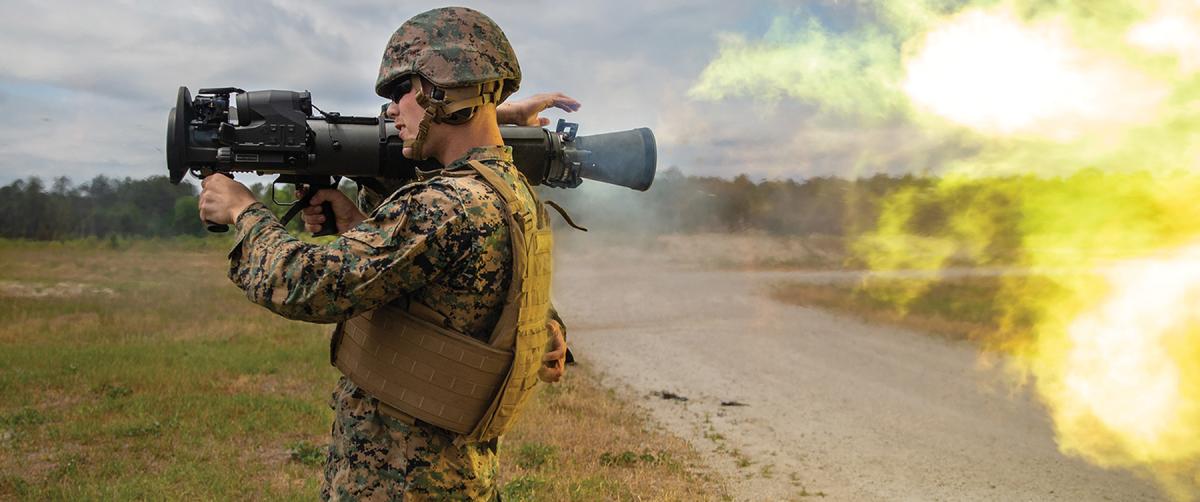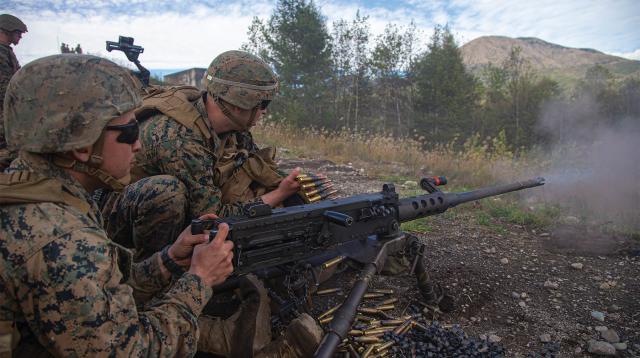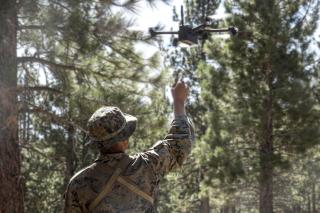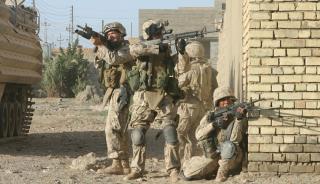Major Michael Hanson

Last year’s Marine Corps Essay Contest winner, “Beyond Force Design 2030,” by Navy Lieutenant (j.g.) Jeong Soo Kim, added to the ongoing debate about restructuring the table of organization and equipment of Marine infantry forces.1 It has been a heated topic since then–Commandant of the Marine Corps General David H. Berger announced sweeping changes to the structure of the Marine Corps in Force Design 2030.
However, this has been a topic of discussion for years, long before General Berger acknowledged it was time to act and called for experimentation to guide an updated force structure. In this regard, many Marines would concur with Lieutenant Kim and General Berger that, as warfare continues to evolve, the force needs to evolve with it. While some observations in last year’s winning article are astute, others miss the mark.
Drone Capabilities

Marines with 3d Battalion, 3d Marines, 3d Marine Division, fire an M2 .50-caliber machine gun during Resolute Dragon 22. Most Marines believe that the infantry exists to support maneuver, and it must have the firepower to do so. U.S. Marine Corps (Diana Jimenez)
“Beyond Force Design 2030” correctly points to the paradigm-changing capability that small unmanned aerial systems (SUASs) bring to ground combat and what they can provide a rifle squad, and the service has made significant strides toward this end. The Marine Corps recognized this fact several years ago, when then-Commandant General Robert Neller approved the “Quads for Squads” program with the goal of equipping every Marine Corps squad with a quadcopter drone.2
Since General Neller’s initiative, Infantry Battalion Experimental (IBX) formations have been pioneering the concept with an impressive array of SUASs in the hands of infantrymen. According to the official U.S. Marine Corps Force Design 2030 webpage, infantry units will get even more SUASs. Marines are slated to get one Black Hornet SUAS per fire team, one SkyDio per squad, one Skyraider per platoon, one RQ-20B Puma per platoon, and one Stalker BLK 30 per company.3
The Marine Corps has already been convinced of the utility of SUASs in its infantry formations. Drones offer infantry leaders at any level—from squad leader to battalion commander—the opportunity to locate, target, and vector force against an enemy. If employed poorly, however, they also can cue an enemy—spoiling the element of surprise or even compromising the user’s position.
Even worse, considering current discomfort with uncertainty and obsession with achieving certainty through large amounts of information, relying on drones can have disastrous effects. Leaders can get sucked into their drone feed and lose control of their unit. A skilled enemy force can close with and attack a halted patrol when a squad stops to launch a drone and methodically search the battlespace. Platoon and company commanders who significantly slow or cease movement can surrender the initiative as well, offering the enemy an exposed unit and a lucrative target—all while trying to gain better situational awareness.
There is a danger that drones have paralyzed not only the infantry’s ability to move, but also its ability to make timely decisions. These are not reasons to avoid using drones—far from it—but Marines must not rely on affirmation from drones before any significant movement or decision is made.
Loitering Munitions
“Beyond Force Design” proposed an infantry squad precision munition team with a team leader, two loitering munitions operators, and a designated marksman. The article specifically cites the 6-pound AeroVironment Switchblade 300—a weapon with a range of 6.2 miles and a payload equivalent to a 40-mm grenade.4 The Switchblade 300, however, is a precision-guided munition with a small payload. It is intended to be a surgical strike weapon at the squad level.
The Marine Corps is currently planning to field the UVision Hero 120—a 45-pound system with a 74.5-mile range.5 The Hero 120 warhead can destroy tanks, like the nearly 50-pound FGM-148 Javelin. However, the Javelin is not a loitering munition and is limited to only a 1.2-mile maximum effective range.6
“Beyond Force Design” envisioned a precision-munition team member armed with an M38 DMR (Designated Marksman Rifle). The M38 DMR is identical to the M27 IAR, with the only difference being the optic—a Leupold TS-30A2 Mk 4 MR/T 2.5-8x36-mm variable-power scope—and the method in which the weapon is employed. Regardless, the maximum effective range of both rifle variants is .34 miles—hardly a long-range weapon.7 The beyond-line-of-sight Hero 120, however, is most certainly a long-range weapon, which is why the Marine Corps wants it.
Small-Unit Air Defense

A Marine launches a Skydio drone during a training exercise. The Marine Corps has already been convinced of the utility of SUASs in its infantry formations, but used incorrectly they could spoil the element of surprise or compromise the user’s position. U.S. Marine Corps (Skyler M. Harris)
Lieutenant Kim proposed an antidrone team using “computerized optics and drone jammers to provide the squad with both ‘hard’ and ‘soft’ antiair capabilities.”8 The soft antiair capability is a jamming device that uses radio waves to disrupt the control of the drone. The Chinese company Hinaray advertises a device like this that is effective from .24 to .62 miles.9 Such a device could be used to prevent drones from getting close to a squad on the ground; however, the advanced optics on modern drones allow many variants to stay comfortably out of range of such a jammer while still being able to observe, track, and provide the location of the unit being surveilled.
The “hard” antiair capabilities described by Lieutenant Kim included “antidrone gunners” armed with M27 IARs, but these are not sufficient weapons for targeting drones. SUASs typically travel at high altitudes and speeds, rendering engagement by Marines with rifles next to impossible.
Despite these facts, the lack of an effective antidrone capability is a well-understood shortfall in the Marine Corps infantry, and Lieutenant Kim has helped bring attention to this fact.
Refashioned Rifle Squad
Finally, in the refashioned rifle squad, the third fire team, which Lieutenant Kim calls the firepower team, is armed with four M27 IARs and one M320 40-mm grenade launcher. For a “firepower team,” this is not much firepower. Specifically, this fire team lacks a responsive direct-fire high-explosive solution capable of reducing a hardened position, such as a bunker or a small building, or destroying an enemy armored vehicle. For years the Marine Corps accounted for these contingencies by equipping its rifle squads with the disposable AT-4 84-mm rocket, effective out to .18 miles, and the 66-mm M72 LAW, effective out to .13 miles.10
Today, the Marine Corps is fielding the M3E1 Multi-Role Anti-Armor Anti-Personnel Weapon System (MAAWS). The 22-pound MAAWS is an 84-mm reloadable recoilless rifle with multiple types of ammunition, such as high-explosive, smoke, and even rocket-assisted rounds. The maximum effective range depends on the target and the munition, but this weapon is effective out to .62 miles with smoke and high-explosive rounds and 1.2 miles with rocket-assisted rounds.11
The ultimate shortfall of the rifle squad configuration in “Beyond Force Design” is that it is a squad of enablers, without anyone to enable. There is a glaring lack of riflemen, which is who everyone else in the Marine Corps exists to support. It does not designate a main effort capable of the conclusive action that Marine Corps infantry exists to achieve: a force to close with and destroy the enemy by fire and maneuver. This lack of a clear task and purpose to a decisive end is what spells failure for this entire squad, because it cannot achieve a decision with respect to the enemy, other than sheer attrition. The squad is burdened with too many purposes for such a small unit, resulting in a force that will not be able to accomplish much. It could only serve one mission—to harass—and may not be able to do that well. It cannot persist, and it cannot finish the job. This is not a force capable of decisive action.
Furthermore, last year’s winning article did not account for heavier crew-served weapons such as the machine guns, mortars, and missiles found in the weapons platoons of an infantry battalion’s rifle and weapons companies. These weapons are critical in a fight with a credible enemy. There is more to infantry than the rifle squad, and a rifle squad cannot be a multipurpose force crammed into one element. Not accounting for these things raises more questions than answers.
Suppression is Critical

U.S. Marines search houses in Fallujah, Iraq, on 13 November 2004. Infantry Marines have a storied history of wresting control of an objective, no matter the clime or circumstance, and any reenvisioned rifle squad must be up to that task. U.S. Marine Corps History Division
Despite these criticisms, last year’s winning essay was right about many things; it just had them in the wrong arrangement. Loitering munitions are revolutionary weapon systems that have changed the paradigm that has existed for generations of infantrymen. The Marine Corps must acquire loitering munitions as soon as possible, but a rifle squad is not the right place for them. They belong in a support squad, like those found in the weapons platoon and weapons company. Furthermore, a loitering munition squad, section, or platoon could bring more loitering munitions to the fight than an overtaxed fire team.
Without a doubt, loitering munitions are a critical shortfall in the Marine Corps’ current arsenal, but two small Switchblade 300s will not give a squad many chances to destroy things. Admittedly, with such a long-range view of the battlespace, a squad could call on loitering munition support from an adjacent squad; however, these are finite weapons that will be used sparingly so as not to waste critical assets, and a unit needs redundant items to attain the desired effect.
Like SUASs, the allure of loitering munitions at the squad level has entranced many people, but the potential offered by these capabilities might confuse some as to the true purpose of the infantry. Most infantry Marines believe suppression is the critical infantry task that exists to support maneuver, which is the decisive element in infantry combat.12 There are those who believe drones and precision munitions have supplanted maneuver as the decisive element on the modern field of battle—that Marines in the future can just sit back at a comfortable distance and plink away at targets until there are no enemies left.
As has happened countless times throughout history and in many climes and places where Marines have fought—from artillery cratered no-man’s lands on the western front in France, to islands such as Tarawa and Iwo Jima pounded by large caliber naval gunfire, to the dense urban areas of Hue City or Fallujah—it takes an infantryman with a rifle, a bayonet, or even bare hands to close with and wrest control of an objective from the enemy. May the Marine Corps never lose sight of that simple fact.
No comments:
Post a Comment